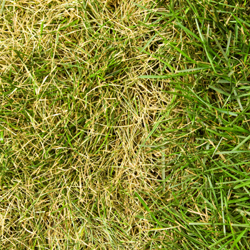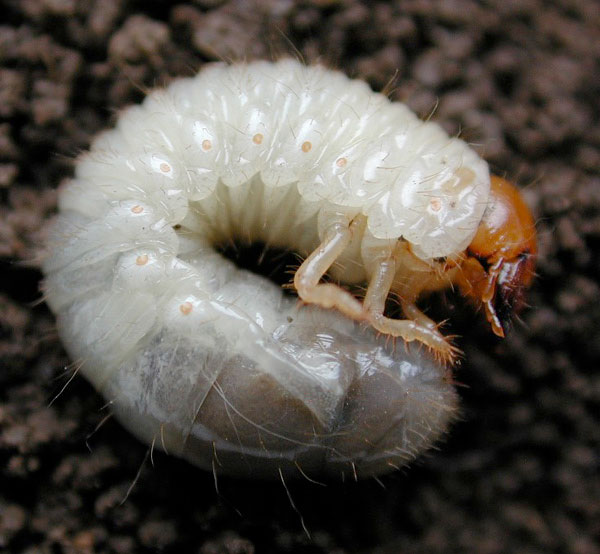There’s a bug called a “grub” that causes brown spots in lawn. It may be feasting on yours…
Lawn grubs, or “white grubs,” are the larvae of scarab beetles. Members of this beetle family include the Japanese beetle, dung beetle and over 30,000 others. Their life spans differ but the larval stage is always a white C-shaped grub. At this stage, in the late summer to fall, they live in the ground eating roots of grasses and other plants before entering the pupae stage from which a beetle emerges.
How can you tell if your lawn has grubs?
In the late summer or early fall, the first sign may be wilting and loss of the rich green color followed by brown irregularly shaped patches. There may be a feeling of “sponginess” in the lawn. As the grubs eat the deeper roots first, this leaves tunnels underground, which our feet feel as spongy. If you notice these symptoms, pull up the browned lawn where it meets green lawn. If it rolls back like a blanket, it could be because grubs ate the roots.
Prevention is always the best way to deal with a potential problem. Knowing the approximate size of the population is important to determine the level of required control. If the population is increasing, it could be due to the buildup of thatch, overuse of chemicals killing the good soil organisms, and/or overwatering the lawn. If the population is not serious, dethatching the lawn, mowing with a mulching lawnmower and reducing the water should reduce the population.
Check your lawn in late summer to determine the grub population. Dig several 1 foot squares 3-4″ deep from various areas of the lawn in the sun. (Grubs are seldom in the shade lawn.) If there, you’ll see them. (Toss into soapy water to kill.) If you find 1-5 grubs, there is no need to treat. A population between 5 and 10 requires a decision. A healthy lawn can support a small population. As grubs need moisture, letting the lawn go dormant may kill the majority. However, more than 10 grubs per square foot will eventually kill the lawn. To add insult to injury, an associated side effect may be digging damage from raccoons and skunks looking for an easy meal.
Non-chemical treatments include spraying beneficial nematodes known as Heterorhabditis or Steinernema onto the lawn. These tiny organisms are parasites to soil grubs and other insect larvae. Other natural predators include ground beetles, ants and parasitoids such as Tiphia. An application of Bacillus popilliae Dutky to the soil causes a fatal (to grubs) disease known as “Milky Spore Disease.” Chemicals such as trichlorfon, imidacloprid, halofenozide or thiamethoxam are also effective. Always read and follow the instructions.
Alert observation and quick action to prevent large-scale damage will reduce the amount of time and effort to renovate an affected lawn.








